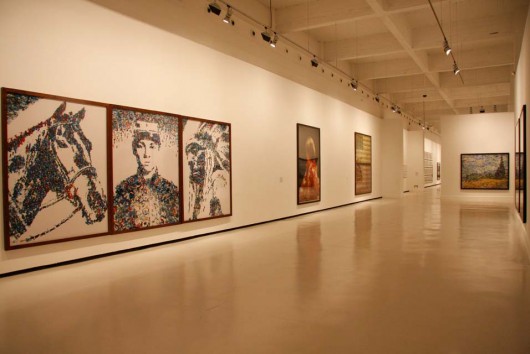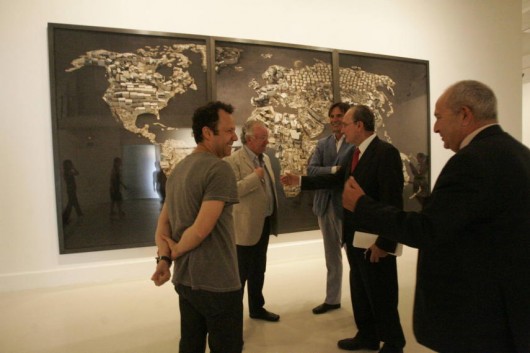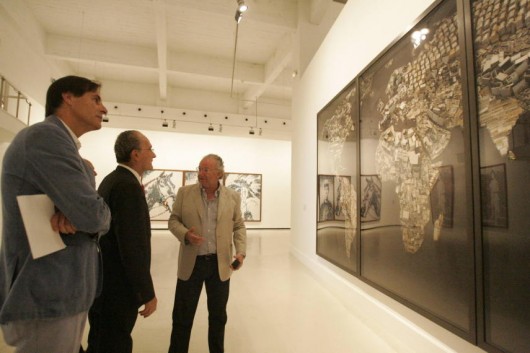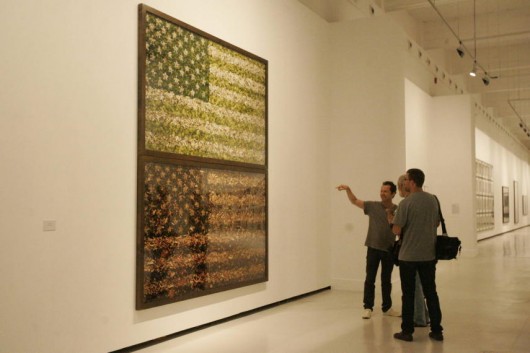The Centro de Arte Contemporáneo de Málaga is presenting the exhibition Vik Muniz. It offers an overview of the artist’s most characteristic work and will be the largest retrospective on Muniz to be shown to date in Europe.
Curated by Fernando Francés, it includes both the artist’s depictions of everyday scenes, faces of celebrities and anonymous individuals as well as Muniz’s selection of famous works of traditional art that he represents in a very different way, recording them in photographic portraits.
Vik Muniz plays with the viewer’s imagination and makes use of highly unconventional materials in his work. Leonardo da Vinci’s Mona Lisa and Caravaggio’s Head of Medusa are seen here as never before. The exhibition comprises more than 100 photographs. Since the late 1980s Vik Muniz has lived and worked in New York. In the words of Vik Muniz (born Sao Paulo, 1961): “Most of what I do combines an approach typical of Pop Art regarding the subject with a painterly viewpoint with respect to procedures and materials.”
Muniz began his career as a sculptor but the need to use photography for documentation when creating his works led him to change his medium of artistic expression. Moving continually between different disciplines such as drawing and sculpture, the artist transmits the unease that he feels by confronting the thin line that divides fiction from reality. His reproductions of great works of traditional art, faces of celebrities and those of anonymous individuals in everyday scenes, all depicted with unconventional materials, make him a unique figure on the contemporary art scene.
For Fernando Francés, director of the CAC Málaga: “When looking closely at the world of Vik Muniz we feel the need to seek out recognisable elements in order to reconstruct the reality that this Brazilian artist evokes in his works. This is a reality that combines elements habitually found in Arte Povera and Pop Art and in collage and installation but less so in photography. This is not, however, an easy game. One has to be aware that Vik Muniz gives out deceptive signals in all his works. He invites the viewer to be led along by the appearance of an image that seems direct and immediate at first sight, especially from a certain distance, but which, when one gets closer, can be described as an illusion or trick. But by then it’s too late.
The work has entrapped the viewer and the surprise consists in the realisation of the existence of a net that captures the gaze, which cannot resist it.” This “game” means that with Vik Muniz’s work all the context, the environment and way in which it reaches the public must be borne in mind. The artist has depicted celebrated icons of contemporary art and traditional works with a different gaze and one that can deceive the viewer. From a certain distance the image represents works of art or faces of well known figures but as we get closer we discover the material from which these images are made and the reflected details, and while on occasions the work does not faithfully reproduce the original, the viewer recognises it perfectly with the added element of realising what it is made of.
One such example is Narcissus (2006), Caravaggio’s original composition but now recreated using rubbish and old junk. Muniz controls optical illusion with unparalleled skill. His work reveals a new approach and another way of interpreting art, while an element of social critique is also present in his work. His materials are not chosen at random or because they fit well into the final result visually. By reproducing faces of Hollywood stars from diamonds (Elizabeth Taylor, 2004) he reveals the aim of making specific celebrities eternal.
A similar intent is evident when he works with sugar (Valentina, The Fastest, 1996), with child workers on plantations or when depicting Brazilian celebrities who appear in gossip magazines, including himself (Self Portrait, 2003) using pieces of paper from those magazines. The use of dust that has collected in museum galleries, tomato sauce and chocolate are other devices that become contextualised in a specific manner in his works. Vik Muniz’s work has involved a major project of visual research. This has been done with both completed series and also with open ones which the artist has not known how to end.
During his researches Muniz aims to find signs of identity that coincide with the various viewpoints that he brings to his work. Living on the edge of a very large city has made him develop his particular way of understanding art. He channels his creativity by making his own toys and illustrating the subjects that he was taught at school. Muniz’s ability to draw earned him a grant aged fourteen to study this discipline. Unable to study psychology, he gained a degree in Communication Studies specialising in advertising and his first work was undertaken within that field. Although this was a somewhat frustrating experience he was able to purchase his ticket to travel to the USA where he developed his artistic abilities in the context of 1980s New York.
In the present exhibition at the CAC Málaga the artist has grouped together part of his extensive oeuvre in series, inviting the viewer to be led along by the illusion that his images evoke. These works are displayed in the principal gallery and part of the space devoted to permanent displays, making this one of the most important exhibitions of Muniz’s work to have taken place in Spain to date. In 2010 Muniz was involved in the making of the documentary Waste Land, directed by Lucy Walker, in which he focused on the world’s largest rubbish dump, Jardim Gramacho, on the outskirts of Rio de Janeiro. The film was nominated for Best Documentary at the Academy Awards.
Over the past decade, notable solo exhibitions of Vik Muniz’s work have included: Beyond the Boundary between Celebrated Painting and Photo at the Jeonbuk Museum of Art, Gana Art Center, Seoul (2011); Vik Muniz at the Nichido Contemporary Art, Tokyo (2010); Vik Muniz at the Museum of Modern Art (MAM) in Rio de Janeiro (2009); Artists’ Choice: Vik Muniz, Rebus, at the MoMA, New York (2008); Vik Muniz Reflex, Museum of Contemporary Art, Montreal, Quebec, Canada (2007); Vik Muniz Reflex. Seattle Art Museum, Washington (2006); Vik Muniz, Pennsylvania Academy of Fine Art, Philadelphia (2005); Diamond Divas and Caviar Monsters, Fundación Telefónica, Madrid (2004); Contemporánea, Santiago de Compostela; the Museum of Contemporary Art, Rome (both 2003); Model Pictures, the Menil Collection, Houston; Laberints, Espao 13, Fundació Joan Miró, Barcelona (both 2002); The Things Themselves: Pictures of Dust by Vik Muniz, Whitney Museum of American Art, New York; and the Museu de Arte Moderna, Rio de Janeiro (both 2001).
More Information: http://www.artdaily.org/index.asp?int_sec=11&int_new=57552#.UEhbTCLpVdw[/url]
Copyright © artdaily.org






